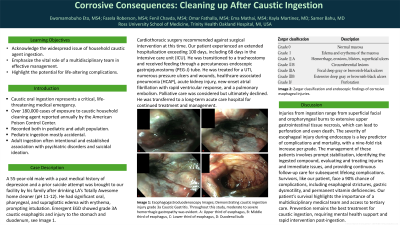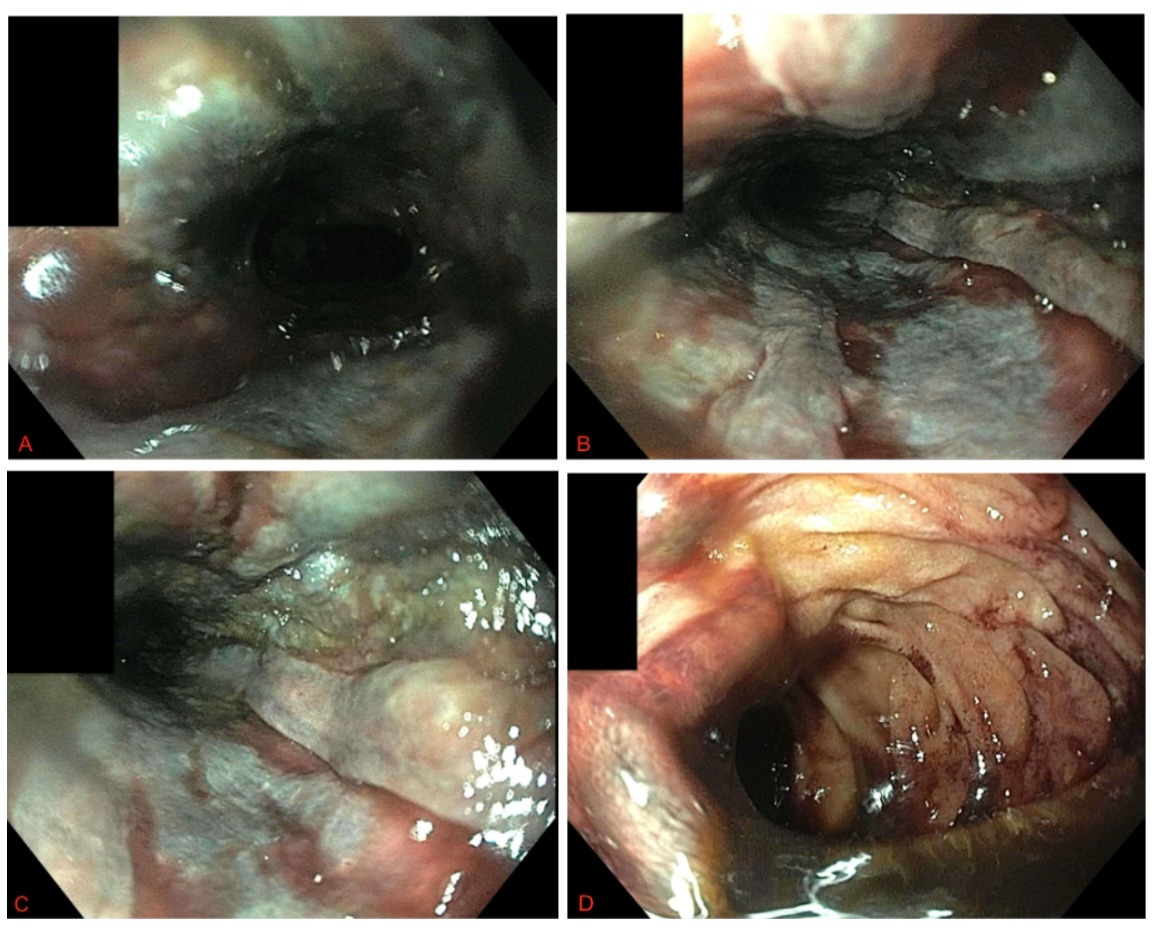Tuesday Poster Session
Category: Esophagus
P4025 - Corrosive Consequences: Cleaning Up After Caustic Ingestion
Tuesday, October 29, 2024
10:30 AM - 4:00 PM ET
Location: Exhibit Hall E

Has Audio

Ewomamobuho Eto, MS
Ross University School of Medicine
Pontiac, MI
Presenting Author(s)
Ewomamobuho Eto, MS1, Fazela Roberson, MS1, Fenil Chavda, MS1, Omar Fathalla, MS1, Ema Mathai, MS1, Kayla Martinez, MD2, Samer Bahu, MD3
1Ross University School of Medicine, Pontiac, MI; 2Detroit Medical Center/Wayne State University, Detroit, MI; 3Trinity Health Oakland / Wayne State University School of Medicine, Pontiac, MI
Introduction: Caustic oral ingestion represents a critical, life-threatening medical emergency with potentially catastrophic outcomes. Annually, the American Poison Control Center reports over 180,000 cases of poison exposure involving caustic household cleaning agents. The majority of these incidents are due to accidental pediatric ingestion; however, adult ingestions are often intentional and have established associations with psychiatric disorders and suicidal ideation/attempt.
Case Description/Methods: A 55-year-old male with a past medical history of depression and a prior suicide attempt was brought to our facility by his family after drinking LA’s Totally Awesome home cleaner (pH 11-12). He had significant oral, pharyngeal, and supraglottic edema with erythema, promoting intubation. Emergent EGD showed grade 3A caustic esophagitis and injury to the stomach and duodenum, see Image 1. Cardiothoracic surgery recommended against surgical intervention at this time. Our patient experienced an extended hospitalization exceeding 100 days, including 68 days in the intensive care unit (ICU). He was transitioned to a tracheostomy and received a percutaneous endoscopic gastrojejunostomy (PEG-J) tube. He was treated for a UTI, numerous pressure ulcers and wounds, healthcare-associated pneumonia (HCAP), acute kidney injury, new-onset atrial fibrillation with rapid ventricular response, and a pulmonary embolism. Palliative care was considered but ultimately declined. He was transferred to a long-term acute care hospital for continued treatment and management.
Discussion: Injuries from ingestion range from superficial facial and oropharyngeal burns to extensive upper gastrointestinal tissue necrosis, which can lead to perforation and even death. The severity of esophageal injury during endoscopy is a key predictor of complications and mortality, with a nine-fold risk increase per grade. The management of these patients involves prompt stabilization, identifying the ingested compound, evaluating and treating injuries and immediate issues, and providing continuous follow-up care for subsequent lifelong complications. Survivors, like our patient, face a 90% chance of complications, including esophageal strictures, gastric dysmotility, and permanent vitamin deficiencies. Our patient’s survival highlights the importance of a multidisciplinary medical team and access to tertiary care. Prevention remains the best treatment for caustic ingestion, requiring mental health support and rapid intervention post-ingestion.

Disclosures:
Ewomamobuho Eto, MS1, Fazela Roberson, MS1, Fenil Chavda, MS1, Omar Fathalla, MS1, Ema Mathai, MS1, Kayla Martinez, MD2, Samer Bahu, MD3. P4025 - Corrosive Consequences: Cleaning Up After Caustic Ingestion, ACG 2024 Annual Scientific Meeting Abstracts. Philadelphia, PA: American College of Gastroenterology.
1Ross University School of Medicine, Pontiac, MI; 2Detroit Medical Center/Wayne State University, Detroit, MI; 3Trinity Health Oakland / Wayne State University School of Medicine, Pontiac, MI
Introduction: Caustic oral ingestion represents a critical, life-threatening medical emergency with potentially catastrophic outcomes. Annually, the American Poison Control Center reports over 180,000 cases of poison exposure involving caustic household cleaning agents. The majority of these incidents are due to accidental pediatric ingestion; however, adult ingestions are often intentional and have established associations with psychiatric disorders and suicidal ideation/attempt.
Case Description/Methods: A 55-year-old male with a past medical history of depression and a prior suicide attempt was brought to our facility by his family after drinking LA’s Totally Awesome home cleaner (pH 11-12). He had significant oral, pharyngeal, and supraglottic edema with erythema, promoting intubation. Emergent EGD showed grade 3A caustic esophagitis and injury to the stomach and duodenum, see Image 1. Cardiothoracic surgery recommended against surgical intervention at this time. Our patient experienced an extended hospitalization exceeding 100 days, including 68 days in the intensive care unit (ICU). He was transitioned to a tracheostomy and received a percutaneous endoscopic gastrojejunostomy (PEG-J) tube. He was treated for a UTI, numerous pressure ulcers and wounds, healthcare-associated pneumonia (HCAP), acute kidney injury, new-onset atrial fibrillation with rapid ventricular response, and a pulmonary embolism. Palliative care was considered but ultimately declined. He was transferred to a long-term acute care hospital for continued treatment and management.
Discussion: Injuries from ingestion range from superficial facial and oropharyngeal burns to extensive upper gastrointestinal tissue necrosis, which can lead to perforation and even death. The severity of esophageal injury during endoscopy is a key predictor of complications and mortality, with a nine-fold risk increase per grade. The management of these patients involves prompt stabilization, identifying the ingested compound, evaluating and treating injuries and immediate issues, and providing continuous follow-up care for subsequent lifelong complications. Survivors, like our patient, face a 90% chance of complications, including esophageal strictures, gastric dysmotility, and permanent vitamin deficiencies. Our patient’s survival highlights the importance of a multidisciplinary medical team and access to tertiary care. Prevention remains the best treatment for caustic ingestion, requiring mental health support and rapid intervention post-ingestion.

Figure: Image 1: Esophagogastroduodenoscopy Images; Demonstrating caustic ingestion Injury Grade 3a Caustic Gastritis. Throughout this study, moderate to severe hemorrhagic gastropathy was evident. A: Upper third of esophagus, B: Middle third of the esophagus, C: Lower third of the esophagus, D: Duodenal bulb.
Disclosures:
Ewomamobuho Eto indicated no relevant financial relationships.
Fazela Roberson indicated no relevant financial relationships.
Fenil Chavda indicated no relevant financial relationships.
Omar Fathalla indicated no relevant financial relationships.
Ema Mathai indicated no relevant financial relationships.
Kayla Martinez indicated no relevant financial relationships.
Samer Bahu indicated no relevant financial relationships.
Ewomamobuho Eto, MS1, Fazela Roberson, MS1, Fenil Chavda, MS1, Omar Fathalla, MS1, Ema Mathai, MS1, Kayla Martinez, MD2, Samer Bahu, MD3. P4025 - Corrosive Consequences: Cleaning Up After Caustic Ingestion, ACG 2024 Annual Scientific Meeting Abstracts. Philadelphia, PA: American College of Gastroenterology.

